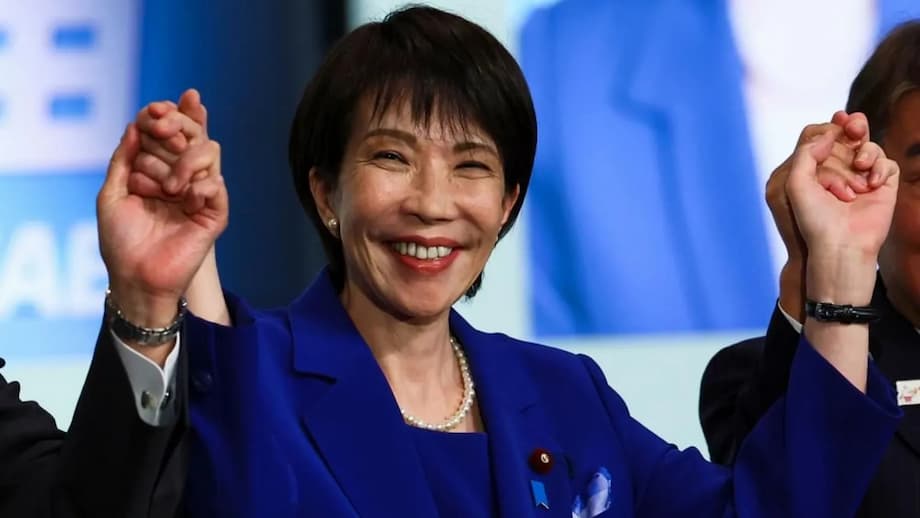A historic first collides with harsh political math
Japan’s governing Liberal Democratic Party (LDP) has chosen Sanae Takaichi, 64, as its new leader, setting the stage for her to become the country’s first female prime minister. The breakthrough is historic. It also arrives at a moment of political fragility and economic strain. Voters face rising prices and weak wage growth, and the LDP is weaker than at any time in recent memory after a string of election setbacks and funding scandals.
Takaichi is a hardline conservative who promises to revive the pro growth formula associated with her mentor, the late Shinzo Abe. She faces a complex to do list from day one. She must stabilize prices and restore confidence at home, navigate a prickly trade relationship with Washington shaped by a baseline 15 percent tariff on Japanese exports, and rebuild a governing coalition after the LDP’s longtime partner walked away. Even if she wins the parliamentary vote, assembling a workable majority for legislation will be a test.
The leadership handover follows the resignation of Prime Minister Shigeru Ishiba after just over a year in office. Repeated defeats cost the LDP and its allies their control of both chambers of parliament, turning what would normally be a routine transfer of power into a struggle for survival. Party members are betting that Takaichi’s clear ideological profile can rally core supporters, even if it limits broader appeal.
How did she win, and what happens in parliament
Takaichi prevailed in a two round leadership election, defeating Agriculture Minister Shinjiro Koizumi in a runoff. The contest included votes from 295 LDP lawmakers and roughly one million dues paying members. Her win ends a decades long pattern of male leaders atop a party that has governed Japan for most of the postwar era.
Japan’s prime minister is chosen in a vote of the Diet. The lower house, with 465 seats, has the decisive say. A candidate must secure a majority of votes cast in the chamber. If no one can reach a majority on the first ballot, the top two advance to a runoff. The LDP holds 196 lower house seats, well short of the 233 needed to command a majority. Complicating matters, the LDP’s junior partner Komeito has quit the coalition. Opposition parties are weighing a united front behind an alternative candidate, potentially Yuichiro Tamaki. An extraordinary parliamentary session is expected in mid October.
Who is Sanae Takaichi
Takaichi’s path differs from many of her peers who hail from political dynasties. Raised in Nara, she interned for a United States Democratic congresswoman before entering Japanese politics. She worked as a TV commentator, rode a motorcycle as a young lawmaker, and even played drums in a heavy metal band, a hobby she still keeps up to manage stress. First elected to parliament in 1993 at age 32, she has been returned to office nine times and has held senior posts, including minister of economic security, internal affairs, and gender equality.
Her public image blends strict discipline with flashes of irreverence. She keeps an electric drum set at home and has joked about playing late at night. Longtime associates describe a singular focus on work. As she celebrated her leadership victory, she urged party lawmakers to put in relentless hours.
Addressing the LDP caucus, she cast aside a popular management mantra in a line that quickly trended online.
“I will abandon the word work life balance. I will work, work, work and work.”
Roots and mentors
Takaichi is a protege of Shinzo Abe and a champion of Abenomics, the strategy that emphasized heavy fiscal spending and ultra cheap credit to spur growth. She has criticized the idea of rapid interest rate increases and signaled support for renewed stimulus. On national security, she wants to revise Japan’s postwar pacifist constitution, bolster the military, and invest in cybersecurity. She is seen as friendly to Taiwan and is a regular visitor to the Yasukuni shrine, a focal point of regional tensions because it honors Japan’s war dead including convicted war criminals.
Her social views are conservative. She backs male only imperial succession, opposes legal changes to allow married couples to retain separate surnames, and does not support same sex marriage. She admires Margaret Thatcher and presents herself as a steward of traditional values. At the same time, she has pledged to appoint more women to senior posts and to expand support for women’s health and fertility treatment.
Economy first: inflation, wages and the yen
Japanese households are squeezed by the sharpest price pressures in years, even as pay growth lags. The yen has been weak, lifting the cost of imported energy and food. The Bank of Japan ended its negative interest rate era in March 2024 and has its policy rate at 0.5 percent, but price growth remains sticky. Takaichi has promised to focus on growth and household relief, signaling more fiscal outlays and caution on rate hikes. She has even floated branding her program Sanaenomics, a nod to the Abe era. Food costs are a political flashpoint, with rice prices recording their fastest increase in more than half a century.
Abenomics was built on three arrows: aggressive monetary easing, government spending, and structural changes to raise productivity. Takaichi clearly favors the first two levers. Structural reform is less defined in her platform, though she talks about strategic investment and deregulation in select industries. Markets will judge how her cabinet balances immediate cost of living support with fiscal credibility.
Hajime Kidera, a professor at Meiji University, warned that investors and families will watch the first months closely.
“That kind of talk can weaken the yen further and raise concerns about Japan’s debt levels. For ordinary people already struggling with rising prices, it is also a serious worry.”
Market reaction captured the tension. The yen slipped on expectations of more stimulus after her party win, then strengthened when coalition uncertainty raised doubts about rapid new spending. Business groups want clarity on the size and timing of any package, and on how it will be paid for.
Security and diplomacy in a tense region
Takaichi is a China hawk who argues that Japan needs to harden its defenses, adapt its cyber posture, and reconsider legal limits on the use of force. Article 9 of the constitution, which renounces war, is her target for revision. Such steps could please allies in Washington that have long pressed Tokyo to shoulder more of the security burden, but they risk friction with Beijing and Seoul. Komeito, a Buddhist backed party with a pacifist streak, has already bristled at her rhetoric.
The United States relationship will be an early test. A recent deal includes a baseline 15 percent tariff on Japanese exports and a pledge by Japan to channel 550 billion dollars of investment into the US economy, alongside purchases of 8 billion dollars a year in US agricultural products. Takaichi has at times talked about revisiting elements of the deal, then said she would work to honor existing commitments. Any renegotiation would be sensitive, especially for autos and semiconductors.
A first face to face meeting with President Donald Trump could come as early as late October if schedules align around regional summits. Takaichi is expected to follow the diplomatic playbook of Abe, who managed a close relationship with Trump while pursuing Japan’s security interests.
In public remarks after her victory, she emphasized the alliances Japan must maintain.
“I will strengthen the Japan US alliance and expand partnerships with South Korea, Australia, and the Philippines.”
At home, any push to increase defense spending or revise the constitution will collide with coalition politics and public opinion. She may calibrate her approach, for example by avoiding a high profile Yasukuni visit during sensitive periods, to keep coalition doors open.
Coalition math and a divided party
The LDP’s path to governing is less straightforward than in past transitions. Komeito, its junior partner for 26 years, announced it would not join a government under Takaichi, citing unresolved concerns about a political funding scandal. That decision removed the simplest route to a working majority and forced the LDP to court new partners or persuade Komeito to return.
Komeito’s leader, Tetsuo Saito, publicly framed the break as a matter of trust.
“The 26 year partnership ended because the party failed to address a political funding scandal.”
Without Komeito, the LDP controls 196 of the lower house’s 465 seats. The opposition holds 175, and several groups are in talks over tactics for the prime ministerial vote. Parties can nominate their own candidates, and if no one wins a majority on the first ballot, the top two go to a runoff. Some in the opposition have discussed rallying behind Yuichiro Tamaki as a unity choice. Business leaders worry that prolonged maneuvering will delay action on prices, immigration, and energy policy.
Inside the LDP, unity is also in question. The party contains centrist and hardline blocs with diverging views on social policy, foreign relations, and fiscal choices. Jeff Kingston, a professor of Asian studies at a Tokyo university, argued that Takaichi’s power base tilts the party rightward at a cost.
“She is in a good position to regain right wing voters, but at the expense of wider popular appeal. She is not much of a healer.”
Her personnel choices will be the first signal. Early reports of plans to reward faction allies, including lawmakers stained by scandals, drew sharp criticism from opposition leaders. If she cannot broaden support in the Diet, any cabinet she forms could be short lived.
Gender breakthrough and the paradox of policy
Japan ranks poorly in global gender equality measures. Women make up about 15 percent of the more powerful lower house, and only two of the nation’s 47 prefectural governors are women. Takaichi’s ascent breaks a barrier inside a male dominated party, yet her policy record is conservative on women’s rights. She opposes allowing married couples to keep separate surnames and rejects same sex marriage. She supports keeping male only succession for the imperial family.
At the same time, she has vowed to name more women to cabinet posts and to expand support for women’s health. She has discussed her own experience with menopausal symptoms and called for educating men about women’s health at school and work. Those gestures could help normalize issues that often stay private in Japanese workplaces.
Whether women see her as an advocate for progress is an open question. Critics argue that symbolic appointments will not change entrenched practices without legal reform on surnames, childcare access, and flexible work. Her quip about abandoning the phrase work life balance split opinion, pleasing supporters who prize grit while unsettling working parents who need supportive policies. Kingston and other analysts say her deference to influential male party figures will shape how far she can go on gender reform.
Her admirers point to her decades of persistence in a system that rarely elevates women, and to her promise to show results by moving more women into positions of authority. Skeptics note that lasting change requires laws, not just appointments.
What her agenda could mean for markets and daily life
Markets are trying to map winners and losers under a Takaichi cabinet. Analysts say consumer focused and defense related stocks could benefit if she launches a large fiscal package and accelerates security procurement. Export sensitive firms could get a boost if the yen weakens again. Banks and real estate could face headwinds if yields stay capped by central bank policy and fiscal discipline slips.
For households, her platform suggests targeted relief to offset living costs. She has floated tax breaks for babysitting and incentives for companies to provide in house childcare. The cost of imports will be critical. A weaker yen would lift energy and food prices, while a stronger yen could ease bills but squeeze exporters. Clarity on the size, timing, and funding of any stimulus will shape how policy filters down to wallets.
On immigration and tourism, she has urged stricter enforcement and tighter rules. During the leadership race, she cited reports of unruly foreign visitors in Nara, then later said her point was to reflect anxieties that many residents voice. Industry groups will watch whether new controls make it harder to fill jobs in sectors like elder care, construction, and hospitality, where labor shortages persist.
Her growth agenda highlights cybersecurity and strategic industries. She wants to bolster domestic capacity in semiconductors, shipbuilding, and pharmaceuticals, areas that feature in the recent 550 billion dollar investment plan tied to US relations. She has also mentioned nuclear fusion research. These priorities reflect a broader push to reduce vulnerabilities in supply chains exposed by geopolitical shocks.
Key Points
- Sanae Takaichi won the LDP leadership and is positioned to become Japan’s first female prime minister, pending a Diet vote.
- The LDP holds 196 of 465 lower house seats. A majority requires 233. A mid October parliamentary vote could go to a runoff if no majority emerges.
- Komeito quit the ruling coalition after 26 years, citing a political funding scandal, leaving Takaichi without a natural governing partner.
- Economy is the top priority. She backs an Abenomics style mix of fiscal spending and low rates as households battle inflation and a weak yen.
- Security agenda includes revising Article 9, higher defense spending, and tougher cyber policy. She aims to strengthen ties with the United States and key partners.
- Social policy remains conservative. She opposes separate surnames for married couples and same sex marriage, while pledging more female ministers and support for women’s health.
- Trade and diplomacy will test her early. A deal with Washington includes 15 percent tariffs on Japanese exports and a 550 billion dollar Japan to US investment pledge.
- Markets see potential gains for consumer and defense sectors, with risks for finance and real estate if fiscal expansion weakens the yen.












